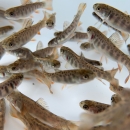The round whitefish is a salmonid species, which is state-listed as “threatened” in New Hampshire. There are currently two round whitefish populations found in New Hampshire waterbodies: Newfound Lake, and Upper Connecticut River. Surveys conducted over the last several years have indicated that the Newfound Lake population is quickly approaching extinction.
Although Nashua hatchery and New Hampshire Fish and Game would prefer to focus the recovery efforts in Newfound Lake, the resident smallmouth bass population is too big of a hurdle for hatchery stock to overcome. That leaves the Upper Connecticut River as the focus of this program. The Upper Connecticut River and Lakes have smaller populations than historically recorded, but they seem to be more stable than the Newfound Lake population.
The New Hampshire Fish and Game initiated a round white fish recovery effort with Nashua hatchery over four years ago. Nashua is currently the only facility in the state that has isolation capabilities, available rearing space, and consistent water quality. In 2017/2018, in partnership with New Hampshire Fish and Game, Nashua NFH completed a pilot project to determine if the facility would be capable of spawning brood stock, incubating eggs, and rearing offspring to a suitable stocking size. Mature individuals were collected in the Upper Connecticut River, and transported back to the hatchery. Nashua was successful; stocking 4,000 fry and 500 fingerlings back into the Upper Connecticut River.


